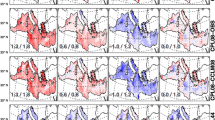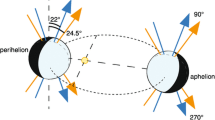Abstract
We integrate the coupled climate model ECHAM5/MPIOM to equilibrium under atmospheric CO2 quadrupling. The equilibrium global-mean surface-temperature change is 10.8 K. The surface equilibrates within about 1,200 years, the deep ocean within 5,000 years. The impact of the deep ocean on the equilibrium surface-temperature response is illustrated by the difference between ECHAM5/MPIOM and ECHAM5 coupled with slab ocean model (ECHAM5/SOM). The equilibrium global-mean surface temperature response is 11.1 K in ECHAM5/SOM and is thus 0.3 K higher than in ECHAM5/MPIOM. ECHAM5/MPIOM shows less warming over the northern-hemisphere mid and high latitudes, but larger warming over the tropical ocean and especially over the southern-hemisphere high latitudes. ECHAM5/MPIOM shows similar polar amplification in both the Arctic and the Antarctic, in contrast to ECHAM5/SOM, which shows stronger polar amplification in the northern hemisphere. The southern polar warming in ECHAM5/MPIOM is greatly delayed by Antarctic deep-ocean warming due to convective and isopycnal mixing. The equilibrium ocean temperature warming under CO2 quadrupling is around 8.0 K and is near-uniform with depth. The global-mean steric sea-level rise is 5.8 m in equilibrium; of this, 2.3 m are due to the deep-ocean warming after the surface temperature has almost equilibrated. This result suggests that the surface temperature change is a poor predictor for steric sea-level change in the long term. The effective climate response method described in Gregory et al. (2004) is evaluated with our simulation, which shows that their method to estimate the equilibrium climate response is accurate to within 10 %.













Similar content being viewed by others
References
Arakawa A, Lamb VR (1977) Computational design of the basic dynamical processes of the UCLA general circulation model. Meth Comput Phys 17:173–265
Boer GJ, Yu B (2003) Climate sensitivity and climate state. Clim Dyn 21:167–176
Cubasch U, Meehl GA, Boer GJ, Stouffer RJ, Dix M, Noda A, Senior CA, Raper S, Yap KS et al (2001) Projections of future climate change. In: Houghton et al. (eds) Climate change 2001: the physical science basis. Contribution of Working Group I to The IPCC Third Assessment Report of the Intergovernmental Panel on Climate Change, Cambridge University, Cambridge, pp 526–582
Danabasoglu G, Gent PR (2009) Equilibrium climate sensitivity: is it accurate to use a slab ocean model. J Clim 22:2494–2499
Gent PR, Willebrand J, McDougall TJ, McWilliams JC (1995) Parameterizing eddy-induced tracer transports in ocean circulation models. J Phy Oceanogr 25:463–474
Gill AE (1982) Atmosphere-ocean dynamics, international geophysics series. Academic Press, Waltham, MA, pp 599–602
Gornitz V, Lebedeff S, Hansen J (1982) Global sea level trend in the past century. Science 215:1611–1614
Gregory JM (2000) Vertical heat transport in the ocean and their effect on time-dependent climate change. Clim Dyn 16:501–515
Gregory JM, Webb M (2008) Tropospheric adjustment induces a cloud component in CO2 forcing. J Clim 21:58–71
Gregory JM, Ingram WJ, Palmer MA, Jones GS, Stott PA, Thorpe RB, Lowe JA, Johns TC, Williams KD (2004) A new method for diagnosing radiative forcing and climate sensitivity. Geophys Res Lett 31. doi:10.1029/2003GL018,747
Griffies SM (1998) The Gent-McWilliams skew-flux. J Phy Oceanogr 28:831–841
Harvey LDD, Schneider SH (1985) Transient climate response to external forcing on 100−104 year time scales part 1: experiments with globally averaged, coupled, atmosphere and ocean energy balance models. J Geophys Res 90:2191–2205
Heinemann M, Jungclaus JH, Li C, Schmidt H, Rast S, Marotzke J (2012) Paleocene–Eocene thermal maximum warming does not require large CO2 forcing. (In preparation)
Held I, Winton M, Takahashi K, Delworth TL, Zeng F, Vallis GK (2010) Probing the fast and slow components of global warming by returning abruptly to pre-industrial forcing. J Clim 23:2418–2427
Hibler WD (1979) A dynamic thermodynamic sea ice model. J Phy Oceanogr 9:815–846
Hoffert MI, Callegari AJ, Hsieh CT (1980) The role of deep sea heat storage in the secular response to climatic forcing. J Geophys Res 85:6667–6679
Holland MM, Bitz CM (2003) Polar amplification of climate change in coupled models. Clim Dyn 21:221–232
Jungclaus JH, Keenlyside N, Botzet M, Haak H, Luo JJ, Latif M, Marotzke J, Mikolajewicz U, Roeckner E (2006) Ocean circulation and tropical variability in the coupled model ECHAM5/MPI-OM. J Clim 19:3952–3972
Knutti R, Hegerl GC (2008) The equilibrium sensitivity of the earth’s temperature to radiation changes. Nat Geosci 1:735–743
Landerer FW, Jungclaus JH, Marotzke J (2007) Regional dynamic and steric sea level change in response to the IPCC-A1B scenario. J Phys Oceanogr 37:296–312
Latif M, Roeckner E, Mikolajewicz U, Voss R (2000) Tropical stabilization of the thermohaline circulation in a greenhouse warming simulation. J Clim 13:1809–1813
Levitus S, Antonov JI, Boyer TP, Stephens C (2000) Warming of the world ocean. Science 287:2225–2229
Levitus S, Antonov JI, Boyer T (2005) Warming of the world ocean, 1955–2003. Geophys Res Lett 32. doi:10.1029/2004GL021592
Levitus S, Antonov JI, Boyer T, Locarnini RA, Garcia HE, Mishonov AV (2009) Global ocean heat content 1955-2008 in light of recently revealed instrumentation problems. Geophys Res Lett 36. doi:10.1029/2008GL037,155
Lyman JM, Good SA, Gouretski VV, Ishii M, Johnson GC, Palmer MD, Smith DM, Willis JK (2010) Robust warming of the global upper ocean. Nature 465:334–337
Manabe S, Stouffer RJ (1980) Sensitivity of a global climate model to an increase of CO2 concentration in the atmosphere. J Geophys Res 85:5529–5554
Marsland SJ, Haak H, Jungclaus JH, Latif M, Roeske F (2003) The Max- Planck-Institute global ocean/sea ice model with orthogonal curvilinear coordinates. Ocean Model 5:91–127
Marčelja S (2010) The timescale and extent of thermal expansion of the global ocean due to climate change. Ocean Sci 6(1):179–184. doi:10.5194/os-6-179-2010
Meehl G, Stocker T, Collins W, Friedlingstein P, Gaye A, Gregory J, Kitoh A, Knutti R, Murphy J, Noda A, Raper S, Watterson I, Weaver A, Zhao ZC (2007) Global climate projections. In Solomon et al. (eds.): Climate change 2007: the physical science basis. Contribution of Working Group I to the Fourth Assessment Report of the Intergovernmental Panel on Climate Change. Cambridge University, Cambridge, U.K. and New York, USA pp 747–845
Pacanowski RC, Philander S (1981) Parameterization of vertical mixing in numerical models of the tropical oceans. J Phy Oceanogr 11:1443–1451
Rahmstorf S (2007) A semi-empirical approach to projecting future sea-level rise. Science 315:368–370
Randall D, Wood R, Bony S, Colman R, Fichefet T, Fyfe J, Kattsov V, Pitman A, Shukla J, Srinivasan J, Stouffer R, Sumi A, Taylor K (2007) Climate models and their evaluation. In Solomon et al. (eds) Climate change 2007: the physical science basis. Contribution of Working Group I to The IPCC Fourth Assessment Report of the Intergovernmental Panel on Climate Change. Cambridge University, Cambridge, U.K. and New York, USA:589–662
Raper SCB, Gregory JM, Osborn TJ (2001) Use of an upwelling-diffusion energy balance climate model to simulate and diagnose AOGCM results. Clim Dyn 17:601–613
Redi MH (1982) Oceanic isopycanal mixing by coordinate rotation. J Phy Oceanogr 12:1154–1158
Roeckner E, Buml G, Bonaventura L, Brokopf R, an M Giorgetta ME, Hagemann S, Kirchner I, Kornblueh L, Manzini E, Rhodin A, Schlese U, Schulzweida U, Tompkins A (2003) The atmospheric general circulation model ECHAM5, Part I: Model description. Max-Planck-Institut für Meteorologie, Rep 349 p, 127 pp
Roeckner E, Brokopf R, Esch M, Giorgetta M, Hagemann S, Kornblueh L, Manzini E, Schlese U, Schulzweida U (2006) Sensitivity of simulated climate to horizontal and vertical resolution in the ECHAM5 atmosphere model. J Clim 19:3771–3791
Semtner AJ (1976) A model for the thermodynamic growth of sea ice in numerical investigations of climate. J Phy Oceanogr 6:379–389
Senior CA, Mitchell JFB (2000) The time dependence of climate sensitivity. Geophys Res Lett 27:2685–2688
Stouffer RJ, Manabe S (1999) Response of a coupled ocean-atmosphere model to increasing atmospheric carbon dioxide: sensitivity to the rate of increase. J Clim 12:2224–2237
Stouffer RJ, Manabe S (2003) Equilibrium response of thermohaline circulation to large changes in atmospheric CO2 concentration. Clim Dyn 20:759–773
Stouffer RJ, Yin J, Gregory J, Dixon K, Spelman M, Hurlin W, Weaver A, Eby M, Flato G, Hasumi H, Hu A, Jungclause J, Kamenkovich I, Levermann A, Montoya M, Murakami S, Nawrath S, Oka A, Peltier W, Robitaille D, Sokolov A, Vettoretti G, Weber N (2006) Investigating the causes of the response of the Thermohaline Circulation to past and future climate changes. J Clim 19:1365–1387
Valcke S, Caubel D, Terray L (2003) OASIS3 Ocean Atmosphere Sea Ice Soil user’s guide. Tech. rep., CERFACS Tech Rep TR/CMGC/03/69, Toulouse, France
Vermeer M, Rahmstorf S (2009) Global sea level linked to global temperature. Proc Nat Acad Sci 106:21,527–21,532. doi:10.1073/pnas.0907765106
von Schuckmann K, Traon PYL (2011) How well can we derive global ocean indicators from Argo data. Ocean Sci 7:783–791. doi:10.5194/os-7-783-2011
Voss R, Mikolajewicz U (2001) Long-term climate changes due to increased CO2 concentration in the coupled atmosphere-ocean general circulation model ECHAM3/LSG. Clim Dyn 17:45–60
Wigley TML, Raper SCB (1987) The thermal expansion of sea water associated with global warming. Nature 330:127–131
Wigley TML, Raper SCB (1992) Implications for climate and sea level of revised IPCC emission scenarios. Nature 357:293–300
Williams KD, Ingram WJ, Gregory JM (2008) Time variation of effective climate sensitivity in GCMs. J Clim 21:5076–5090
Winton M, Takahashi K, Held IM (2010) Importance of ocean heat uptake efficacy to transient climate change. J Clim 23:2333–2344
Acknowledgments
We thank Dr. Helmuth Haak for his assistance in setting up the experiment and for providing the pre-industrial control simulation. We thank Dr. Malte Heinemann for discussions and suggestions on the ozone adaptation and negative optical thickness problems. We thank Dr. Hongmei Li and Mr. Peter Dueben for discussions and improving the language of the paper. We thank Dr. Aiko Voigt for providing the codes to calculate the ocean heat transport. We appreciated the careful and constructive comments from the anonymous reviewers. The model simulations were carried out on the supercomputing system of the German Climate Computation Center (DKRZ) in Hamburg.
Author information
Authors and Affiliations
Corresponding author
Rights and permissions
About this article
Cite this article
Li, C., von Storch, JS. & Marotzke, J. Deep-ocean heat uptake and equilibrium climate response. Clim Dyn 40, 1071–1086 (2013). https://doi.org/10.1007/s00382-012-1350-z
Received:
Accepted:
Published:
Issue Date:
DOI: https://doi.org/10.1007/s00382-012-1350-z




